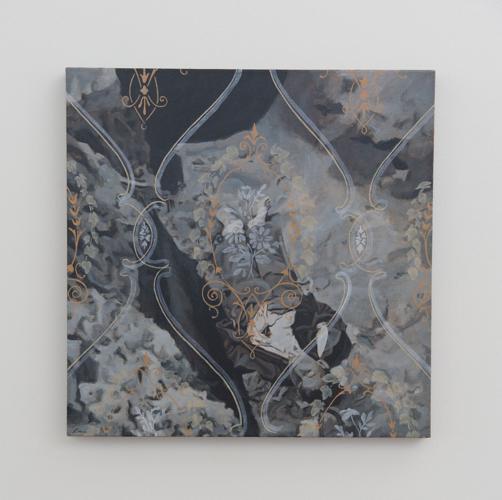
"Reef," Adrienne Outlaw
The first iteration of The Key Show was co-curated by Zeitgeist director Lain York and Ground Floor Gallery + Studios founder Janet Decker Yanez at the Browsing Room Gallery in the fall. The title of the exhibition refers to its artists as former key-holders of the studio and gallery spaces at the Houston Station building and the former May Hosiery Mill. The September show included work by Greg Pond, Beth Gilmore, Michael McBride, Adrienne Outlaw and Dane Carder as well as Yanez and York. Underground institutions like the Fugitive Art Center and Seed Space were born in those buildings, and countless creatives passed through the affordable art studios that were once available in the reimagined industrial spaces.
The Wedgewood-Houston art scene sprang to life in the late 1990s when a diverse creative community was drawn to the new artist-run galleries and studios. A ragtag tribe of DIY creators — not commercial galleries or arts institutions — provided the proof of concept that Wedgewood-Houston could be transformed into a contemporary art hub. At around the same time, development began to push those artists out: Houston Station is now a destination for restaurants and retail; the old May Hosiery Mill is now home to Soho House Nashville, an exclusive members-only hotel and club. It’s the Bizarro World version of the casual cooperatives that fueled the creative community at the place that local artists simply called “the Chestnut Building.”
The latest version of The Key Show, which opened June 1, reads like a grown-up version of that original show in a comparatively sprawling display at Zeitgeist. The opening reception was brimming with veteran art scenesters, and the First Saturday fête felt like a class reunion for the studio community that made Wedgewood-Houston 1.0 a reality. Zeitgeist was one of the first commercial galleries to show and represent the emerging creators who cut their teeth as artists and curators at the Fugitive, and since the gallery relocated from Hillsboro Village to Wedgewood-Houston in 2013, it’s become emblematic of ascendancy of the 2.0 version of Wedgewood-Houston’s contemporary art scene. Twenty-five artists are included in this version of The Key Show, and while there are some eye-catching pieces, it’s really the roster that tells the story here.
Greg Pond’s “Guncotton Coordinates” is an abstract print from a digital motion capture of a dancer. Guncotton was a collaboration between Pond and New Dialect contemporary dance troupe founder Banning Bouldin between 2017 and 2018. Their interdisciplinary works spanned dance, video, sculpture and sound art, and the print reads like a cryptic logo, capturing a complex creative project in one single image. Pond is the co-founder — along with poet-artist Bryan Hunter — of the Fugitive Art Center, an art space and curatorial collective named for the literary movement formed at Vanderbilt University in the 1920s. The Fugitive hosted out-of-town and even international artists in its massive gallery space, and later curated locals in a hallway gallery at the building’s Houston Street entrance. Many artists had studio spaces at the Fugitive, and their opening-reception after-party dance marathons are the sweaty stuff of legend. It was actually a July 2004 Scene cover story about the art center that caught the attention of Nashville’s fire marshal, and an inspection determined that the Fugitive could no longer host public exhibitions. The studios lasted for a little while, and the curatorial collective shifted to touring new-media exhibitions, but the dream was over.

"Lullaby," Dane Carder
Nashville native Adrienne Outlaw made work in a studio at the Chestnut Building for years, and the artist’s long-lived Seed Space gallery got its start as a humble curatorial project in a corner of the artist’s workspace. Outlaw is now based in St. Louis, and her sculpture made from recycled materials greets visitors as they enter The Key Show. “Reef” is a two-paneled tapestry made of bottle caps, zip ties and vinyl-coated hardware cloth. Its playful, rattling construction and ebullient color palette make it one of the most memorable works in the show.
Dane Carder’s “Lullaby” painting pictures a slain Civil War-era soldier through the cursive lines of a contemporaneous wallpaper design. Carder is a self-taught painter who developed the aesthetic of his Civil War works in his studio at the Chestnut Building before his paintings leaped into the Southern contemporary art conversation, championed by the late, great Nashville novelist Robert Hicks. Carder’s studio was also home to the Threesquared gallery, which was curated by local writer and artist Sara Estes.
Mike Calway-Fagen and Julian Rogers shared a studio across the hallway from Outlaw/Seed Space and Carder/Threesquared. Like that pair, Calway-Fagen and Rogers made work in their shared studio space, but also curated experimental exhibitions under the name Sooplex. Calway-Fagen’s addition to The Key Show is a short video titled “White Gold” — it features a mustachioed hipster huffing fumes from a spray can before turning it on himself and painting his face gold.
How does that poem from that movie go?
“So dawn goes down to day.
Nothing gold can stay.”
Joe Nolan’s book Nowville: The Untold History of Nashville’s Contemporary Art Scene will be released in November via Vanderbilt University Press.


